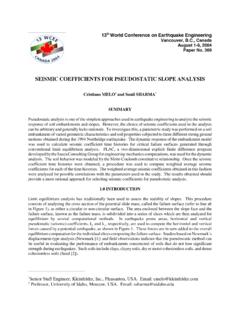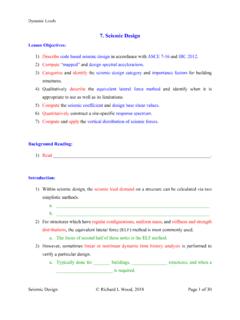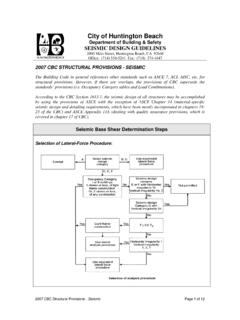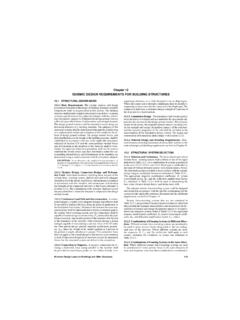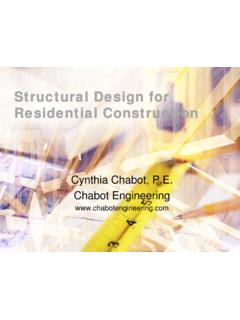Transcription of The Pushover Analysis, explained in its Simplicity
1 The Pushover analysis , explained in its Simplicity Rahul Leslie1, Assistant Director, Buildings Design, DRIQ Board, Kerala PWD, Trivandrum. Introduction One of the emerging fields in seismic design of structures is the Performance Based Design. The subject is still in the realm of research and academics, and is only slowly emerging out into the practitioner's arena. seismic design is slowly transforming from a stage where a linear elastic analysis for a structure was sufficient for both its elastic and ductile design, to a stage where a specially dedicated non-linear procedure is to be done, which finally influences the seismic design as a whole. The basis for the linear approach lies in the concept of the Response Reduction factor R. When a structure is designed for a Response Reduction factor of, say, R = 5, it means that only 1/5th of the seismic force is taken by the Limit State capacity of the structure.
2 Further deflection is in its ductile behaviour and is taken by the ductile capacity of the structure. In Reinforced Concrete (RC) structures, the members (ie., beams and columns) are detailed such as to make sure that the structure can take the full impact without collapse beyond its Limit State capacity up to its ductile capacity. In fact we never analyse for the ductile part, but only follow the reinforcement detailing guidelines for the same. The drawback is that the response beyond the limit state is neither a simple extrapolation, nor a perfectly ductile behaviour with pre- determinable deformation capacity. This is due to various reasons: the change in stiffness of members due to cracking and yielding, P-delta effects, change in the final seismic force estimated, etc. Although elastic analysis gives a good indication of elastic capacity of structures and shows where yielding might first occur, it cannot account for redistribution of forces during the progressive yielding that follows and predict its failure mechanisms, or detect possibility and location of any premature failure.
3 A non-linear static analysis can predict these more accurately since it considers the inelastic behaviour of the structure. It can help identify critical members likely to reach critical states during an earthquake for which attention should be given during design and detailing. The need for a simple method to predict the non-linear behaviour of a structure under seismic loads saw light in what is now popularly known as the Pushover analysis (PA). It can help demonstrate how progressive failure in buildings really occurs, and identify the mode of final failure. Putting simply, PA is a non-linear analysis procedure to estimate the strength capacity of a structure beyond its elastic limit (meaning Limit State) up to its ultimate strength in the post-elastic range. In the process, the method also predicts potential weak areas in the structure, by keeping track of the sequence of damages of each and every member in the structure (by use of what are called hinges' they hold).
4 Pushover vs Conventional analysis In order to understand PA, the best approach would be to first see the similarities between PA and the conventional seismic analysis (SA), both seismic Coefficient and Response Spectrum methods described in IS:1893-2002 for SA, which most of the readers are familiar with, and then see how they are different: Both SA and PA apply lateral load of a predefined vertical distribution pattern on the structure. In SA, the lateral load is distributed either parabolically (in seismic Coefficient method) or proportional to the modal combination (in the direct combination method of Response Spectrum). In PA, the distribution is proportional to height raised to the power of k', where k (equivalent to 2' in the equation under Cl. in IS:1893-2002) can be equal to 0 (uniform distribution), 1 (the inverted triangle distribution), 2 (parabolic distribution as in the seismic coefficient method) or a calculated 1.
5 Correspondence: 1. value between 1 and 2, the value of k being based on the time period T of the structure, as per the FEMA 356 (where k is given a value of 2 if T seconds, a value of 1 if T seconds and interpolated for intermediate values of T). The distribution can also be proportional to either the first mode shape, or a combination of modes. In both SA and PA, the maximum lateral load estimated for the structure is calculated based on the fundamental time period of the structure. And the last point above is precisely where the difference starts. While in SA the initial time period is taken to be a constant (equal to its initial value), in PA this is continuously re-calculated as the analysis progresses. The differences between the procedures are as follows : SA uses an elastic model, while PA uses a non-linear model. In the latter this is incorporated in the form of non-linear hinges inserted into an otherwise linear elastic model which one generates using a common structural analysis & design software package (like SAP2000 or ), having facilities for PA.
6 The hinges Hinges are points on a structure where one expects cracking and yielding to occur in relatively higher intensity so that they show high flexural (or shear) displacement, as it approaches its ultimate strength under cyclic loading. These are locations where one expects to see cross diagonal cracks in an actual building structure after a seismic mayhem, and they are found to be at the either ends of beams and columns, the cross' of the cracks being at a small distance from the joint that is where one is expected to insert the hinges in the beams and columns of the corresponding computer analysis model. Hinges are of various types namely, flexural hinges, shear hinges and axial hinges. The first two are inserted into the ends of beams and columns. Since the presence of masonry infills have significant influence on the seismic behaviour of the structure, modelling them using equivalent diagonal struts is common in PA, unlike in the conventional analysis , where its inclusion is a rarity.
7 The axial hinges are inserted at either ends of the diagonal struts thus modelled, to simulate cracking of infills during analysis . Basically a hinge represents localised force-displacement relation of a member through its elastic and inelastic phases under seismic loads. For example, a flexural hinge represents the moment-rotation relation of a beam of which a typical one is as represented in AB represents the linear elastic range from unloaded state A to its effective yield B, followed by an inelastic but linear response of reduced (ductile). stiffness from B to C. CD shows a sudden reduction in load resistance, followed by a reduced resistance from D to E, and finally a total loss of resistance from E to F. Hinges are inserted in the structural members of a framed structure typically as shown in These hinges have non-linear states defined as Immediate Occupancy' (IO), Life Safety' (LS) and Collapse Prevention' (CP) within its ductile range.
8 This is usually done by dividing B-C into four parts and denoting IO, LS and CP, which are states of each individual hinges (in spite of the fact that the structure as a whole too have these states defined by drift limits). There are different criteria for dividing the segment BC. For instance, one such specification is at 10%, 60%, and 90%. of the segment BC for IO, LS and CP respectively (Inel & Ozmen, 2006). 2. : A Typical Flexural Hinge Property, showing : Typical Locations of Hinges in a Structural Model IO (Immediate Occupancy), LS (Life Safety) and CP. (Collapse Prevention). The two stage design approach Although hinge properties can be obtained from charts of average values included in FEMA356, ATC-40 and FEMA 440 (which are only rough estimates), for accurate results one requires the details of reinforcement provided in order to calculate exact hinge properties (using concrete models such as the Confined Mander model available in the SAP2000 software package).
9 And one has to design the structure in order to obtain the reinforcement details. This means that PA is meant to be a second stage analysis . Thus the emerging methodology to an accurate seismic design is: (1) first a linear seismic analysis based on which a primary structural design is done; (2) insertion of hinges determined based on the design and then (3) a Pushover analysis , followed by (4) modification of the design and detailing, wherever necessary, based on the latter analysis . On SA, the analysis results are always the elastic (limit state) forces (moment, shear and axial forces). to be designed for. In PA, in the global sense, it is the base shear (Vb) vs roof top displacement ( roof top, taken as displacement of a point on the roof, located in plan at the centre of mass), plotted up to the termination of the analysis . At a local level, it is the hinge states to be examined and decided on the need for its redesign or a retrofit.
10 PA can be useful under two situations: When an existing structure has deficiencies in seismic resisting capacity (due to either omission of seismic design when built, or the structure becoming seismically inadequate due to a later upgradation of the seismic codes) is to be retrofitted to meet the present seismic demands, PA can show where the retrofitting is required and how much. In fact this was what PA was originally developed for, and for which it is still widely used. For a building in its design phase, PA results help scrutinise and fine tune the seismic design based on SA, which is slowly becoming more of a standard procedure for large critical structures. SA, being a linear analysis , is done independently for dead and live loads, and the results added up to give the design forces. But since PA is non-linear, the gravity loads and the lateral load cases are applied sequentially in a single analysis .
